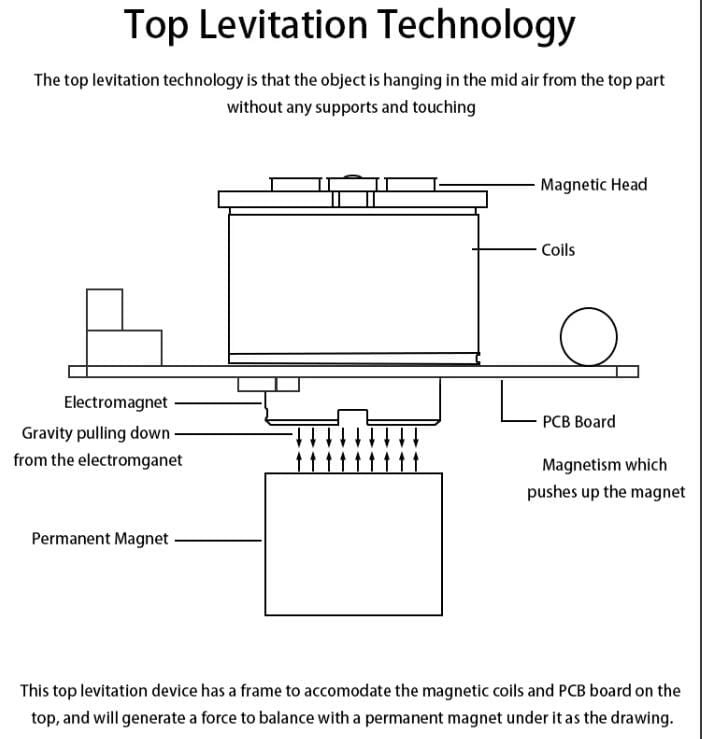Die Wissenschaft des schwebenden: Wie magnetische Levitation tatsächlich funktioniert

Stellen Sie sich vor, Sie platzieren zwei Magnete nahe beieinander und beobachten, wie einer über dem anderen schwebt. Mit der Magnetschwebebahn können Sie Objekte schweben sehen, ohne etwas zu berühren. Das sieht man an Magnetschwebebahnen, die über Gleisen gleiten. Das Geheimnis liegt in der Physik – magnetische Kräfte schieben oder ziehen Objekte, sodass sie in der Luft schweben können.
Key Takeaways
Durch die Magnetschwebebahn können Objekte mithilfe magnetischer Kräfte schweben, Dadurch entfällt die Notwendigkeit eines physischen Kontakts.
Elektromagnetische Schwebesysteme nutzen schnell schaltende Elektromagnete und Sensoren, um die Stabilität und Kontrolle schwebender Objekte aufrechtzuerhalten.
Supraleiter zeigen den Meissner-Effekt, Ermöglicht eine stabile Levitation durch Ausstoßen magnetischer Felder, was für Technologien wie Magnetschwebebahnen von entscheidender Bedeutung ist.
Magnetschwebebahnen reduzieren die Reibung, Dies ermöglicht eine schnellere Fortbewegung und geringere Energiekosten, Dies macht sie zu einer umweltfreundlichen Transportmöglichkeit.
Neue Technologien in der Magnetschwebebahn versprechen Fortschritte in verschiedenen Bereichen, inklusive Transport, Herstellung, und medizinische Geräte.
Grundlagen der Magnetschwebebahn

Was ist das?
Sie fragen sich vielleicht, wie etwas ohne Schnüre oder Stützen in der Luft schweben kann. Magnetschwebebahn ist eine Methode, die Objekte mithilfe magnetischer Kräfte schweben lässt. Wenn Sie einen schwebenden Magneten oder eine schwebende Plattform sehen, Sie beobachten die Kraft der Physik in Aktion. Magnetische Levitation nutzt unsichtbare Magnetfelder, um Objekte zu schieben oder zu ziehen, Halten Sie sie über einer Oberfläche schwebend. Dieser Vorgang erfordert keinen physischen Kontakt, Das Objekt scheint also mitten in der Luft zu schweben.
Magnetische Levitation funktioniert, weil Magnetfelder Kräfte erzeugen können, die stark genug sind, um die Anziehungskraft der Schwerkraft auszugleichen. Das sieht man an Magnetschwebebahnen, wo der Zug über den Gleisen schwebt, Reduziert die Reibung und ermöglicht eine reibungslose Bewegung.
Elektromagnetische Levitation nutzt ein System aus Elektromagneten und Sensoren. Diese Elektromagnete schalten sich sehr schnell ein und aus – ca 100,000 Mal pro Sekunde. Sensoren erfassen die Position des schwebenden Objekts. Das Steuersystem passt die Stärke und das Timing jedes Elektromagneten an, um das Objekt stabil zu halten und ein Umkippen zu verhindern. Durch diese sorgfältige Balance können Sie Objekte wie von Zauberhand schweben sehen.
Bei der elektromagnetischen Levitation werden schnell schaltende Elektromagnete verwendet.
Sensoren erfassen die Position und das Gewicht des Objekts.
Steuerkreise passen die Magnete an, um das Objekt stabil zu halten.
Wie es der Schwerkraft trotzt
Die magnetische Levitation beruht auf den Prinzipien der Physik, um der Schwerkraft entgegenzuwirken. Verschiedene Methoden nutzen unterschiedliche physikalische Effekte, um dieses Gleichgewicht zu erreichen. Hier ist eine Tabelle, die einige der wichtigsten Prinzipien zeigt:
Prinzip | Beschreibung |
|---|---|
Supraleiter stoßen Magnetfelder aus, Dadurch können sie Magnete über sich schweben lassen. | |
Diamagnetismus | Bestimmte Materialien können in einem Magnetfeld schweben, der Schwerkraft durch Abstoßung entgegenwirken. |
Elektromagnetismus | Durch die Wechselwirkung magnetischer Kräfte können Bedingungen geschaffen werden, um die Gravitationskräfte effektiv auszugleichen. |
Michael Faraday untersuchte im 19. Jahrhundert den Diamagnetismus, Dies zeigt, dass einige Materialien in einem Magnetfeld schweben können. Lord Kelvin bewies später, dass diamagnetische Substanzen schweben können. Heute, Sie sehen diese Prinzipien in der schwerkraftfreien Technologie in Aktion, wo magnetische Levitation dabei hilft, Stabilität zu schaffen, schwimmende Systeme. Durch den Einsatz der richtigen Materialien und Magnetfelder, Sie können Objekte schweben lassen, schweben, und bewegen Sie sich, ohne etwas zu berühren. Dies ist die Wissenschaft hinter vielen modernen Erfindungen, die auf Magnetschwebebahn basieren.
Prinzipien der Levitation
Magnetische Felder
Jedes Mal, wenn Sie einen Kompass verwenden oder mit Magneten spielen, sehen Sie Magnetfelder am Werk. In der Magnetschwebebahn, Diese unsichtbaren Felder erzeugen Kräfte, die Objekte schweben lassen. Wenn Sie einen schwebenden Magneten über einer schwimmenden Plattform platzieren, Das Magnetfeld drückt gegen die Schwerkraft. Diese nach oben gerichtete Kraft muss stark genug sein, um zu verhindern, dass das Objekt herunterfällt.
Auftriebskräfte Schieben Sie Gegenstände nach oben und helfen Sie ihnen, in der Luft zu bleiben.
Die Stabilität verhindert, dass das Objekt verrutscht oder umkippt.
Verschiedene Arten von Magneten, wie Permanentmagnete, Elektromagnete, und supraleitende Magnete, Helfen Sie uns dabei, den Aufzug zu schaffen, den Sie brauchen.
Die Physik erklärt, wie diese Felder mit Objekten interagieren. Das sieht man an der schwerkraftfreien Technik, wo magnetische Felder Dinge an Ort und Stelle halten, ohne sie zu berühren.
Abstoßung und Anziehung
Magnete haben zwei Pole: Norden und Süden. Wenn man gleichartige Pole zusammenbringt, sie stoßen sich voneinander ab. Diese Abstoßung kann dazu führen, dass Objekte über einer Oberfläche schweben oder schweben. Wenn Sie die Magnete genau richtig anordnen, Sie können ein Objekt ruhig in der Luft halten.
Magnetische Kräfte nutzen sowohl Anziehung als auch Abstoßung Levitation zu erreichen.
Wie Pole, die sich abstoßen, Dies hilft Ihnen, Objekte aufzuhängen und in der Schwebe zu halten.
Gegensätzliche Pole ziehen sich an, und Sie können diesen Zug nutzen, um schwebende Objekte auszubalancieren und zu stabilisieren.
Die Physik zeigt, dass man diese Kräfte kontrollieren kann, um erstaunliche Effekte zu erzielen, wie eine schwimmende Plattform oder ein schwebender Zug.
Verwendete Materialien
Für die Magnetschwebebahn benötigen Sie spezielle Materialien. Jeder Typ verfügt über einzigartige Eigenschaften, die beim Schwimmen und der Stabilität helfen. Hier ist eine Tabelle, die einige gängige Schwebematerialien und ihre Besonderheiten zeigt:
Materialtyp | Einzigartige Eigenschaften |
|---|---|
Verwenden Sie Flux Pinning, um magnetische Feldlinien zu sperren, Ermöglicht eine stabile Levitation über Permanentmagneten. | |
Permanentmagnete | Erzeugen Sie starke Magnetfelder, die mit Supraleitern interagieren, um eine reibungslose Bewegung zu ermöglichen. |
Erzeugen Sie eine abstoßende Kraft, wenn Sie Magnetfeldern ausgesetzt werden, ermöglicht das Schweben über starken Magneten. |
Supraleiter können Magnetfelder einfangen und Objekte stabil halten. Diamagnetische Materialien, wie pyrolytischer Graphit, Drücken Sie sich von starken Magneten weg und schweben Sie in der Luft. Es können auch ferromagnetische Materialien verwendet werden, Ihr Verhalten hängt jedoch von den Magnetfeldern um sie herum ab. Die Physik hilft Ihnen zu verstehen, wie diese Materialien zusammenarbeiten, um die Magnetschwebebahn zu ermöglichen.
Wie es funktioniert
Bei der Magnetschwebebahn werden verschiedene Werkzeuge und Materialien eingesetzt, um Objekte zum Schweben zu bringen. Sie können dies an einem schwebenden Magneten sehen, eine schwimmende Plattform, oder sogar in schwerkraftfreier Technologie. Jede Methode nutzt die Physik auf einzigartige Weise. Schauen wir uns an, wie Permanentmagnete funktionieren, Elektromagnete, und Supraleiter helfen Ihnen, den Schwebeflug zu erreichen.
Permanentmagnete
Permanentmagnete nutzen ihre eigenen Magnetfelder, um Gegenstände anzuheben. Sie benötigen keinen Strom, damit sie funktionieren. Wenn Sie zwei gleiche Stangen zusammenstellen, sie stoßen sich voneinander ab. Diese Kraft kann dazu führen, dass ein Magnet über einem anderen schwebt. Dies sieht man häufig bei einfachen wissenschaftlichen Spielzeugen oder Schreibtischgeräten.
Hier ist ein kurzer Blick darauf Vor- und Nachteile der Verwendung von Permanentmagneten zum Schweben:
Vorteile von Permanentmagneten | Nachteile von Permanentmagneten |
|---|---|
Sorgen Sie für ein gleichmäßiges Magnetfeld, ohne dass eine externe Stromquelle erforderlich ist | Magnetische Eigenschaften sind festgelegt, Einschränkung der Vielseitigkeit |
Langlebig und resistent gegen Umwelteinflüsse | Temperaturbeschränkungen können die magnetischen Eigenschaften verschlechtern |
Hohe Energieumwandlungseffizienz | Herausforderungen bei der Magnetisierung oder Entmagnetisierung |
Starke Magnetfelder trotz kompakter Größe | Bestimmte Materialien sind spröde und bruchanfällig |
Permanentmagnete bieten Ihnen eine einfache Möglichkeit, die Physik in Aktion zu sehen. Jedoch, Sie können ihre Stärke nicht ändern, und sie können zerbrechen, wenn Sie sie fallen lassen. Sie müssen sie auch sorgfältig anordnen, um die schwimmende Plattform stabil zu halten.
Elektromagnete
Elektromagnete nutzen elektrischen Strom, um Magnetfelder zu erzeugen. Sie können sie ein- oder ausschalten und ihre Stärke anpassen. Dadurch haben Sie mehr Kontrolle über den Levitationsprozess. In Magnetschwebesystemen, Sensoren und Rückkopplungsschleifen helfen Ihnen, das Objekt ruhig zu halten.
Elektromagnete ermöglichen es Ihnen Steuern Sie die Höhe und Position des schwebenden Objekts.
Hall-Effekt-Sensoren messen die genaue Stelle des schwebenden Magneten.
Das System schaltet die Elektromagnete sehr schnell ein und aus, um 100,000 Mal pro Sekunde.
Sie benötigen ein Mindestgewicht für den schwimmenden Gegenstand, um ihn stabil zu halten.
Elektromagnete helfen Ihnen beim Aufbau fortschrittlicher schwerkraftfreier Technologie. Sie können das System in Echtzeit anpassen, Dies macht es nützlich für Magnetschwebebahnen und andere bewegliche Plattformen. Mit der Physik können Sie Elektrizität und Magnetismus gemeinsam für einen reibungslosen Ablauf nutzen, kontrollierte Levitation.
Supraleiter
Supraleiter bringen die magnetische Levitation auf die nächste Stufe. Wenn du Kühlen Sie diese speziellen Materialien auf sehr niedrige Temperaturen, sie verlieren jeglichen elektrischen Widerstand. Das bedeutet, dass sie elektrischen Strom transportieren können, ohne Energie zu verlieren. Supraleiter erzeugen starke Magnetfelder und zeigen einen besonderen Effekt, der als Supraleiter bezeichnet wird Meissner-Effekt.
Der Meissner-Effekt tritt auf, wenn ein Supraleiter alle Magnetfelder aus seinem Inneren verdrängt. Dadurch ist es möglich, dass ein Magnet über einem Supraleiter schwebt. Sie können dieses Experiment ausprobieren:
Platzieren Sie einen Magneten auf einer supraleitenden Scheibe.
Kühlen Sie die Scheibe unter ihre Übergangstemperatur ab.
Beobachten Sie, wie der Magnet zu schweben beginnt, während die Scheibe das Magnetfeld ausstößt.
Supraleiter nutzen Oberflächenströme, um Magnetfelder in ihrem Inneren aufzuheben. Dadurch bleiben schwebende Materialien an ihrem Platz, selbst wenn Sie den Supraleiter neigen oder bewegen. Mit der Quantenlevitation können Sie sehen, wie ein Magnet sanft über eine Schiene gleitet, von unsichtbaren Kräften an Ort und Stelle gehalten. Die Physik erklärt, wie diese Materialien stabil entstehen, Reibungslose Bewegung.
Supraleiter, Elektromagnete, und Permanentmagnete nutzen die Physik jeweils auf unterschiedliche Weise. Supraleiter zeigen Nullwiderstand und der Meissner-Effekt, Das ist der Schlüssel für eine stabile Levitation. Elektromagnete geben Ihnen Kontrolle und Flexibilität, während Permanentmagnete einfach bieten, Zuverlässiges Schweben ohne Strombedarf.
Sie können je nach Bedarf die beste Methode auswählen. Wenn Sie ein einfaches Schreibtischspielzeug möchten, Permanentmagnete funktionieren gut. Für eine Magnetschwebebahn, Sie benötigen Elektromagnete oder Supraleiter. Jede Methode hilft Ihnen, die Wunder der Magnetschwebebahn und die Kraft der Physik zu erkunden.
Der Schwerkraft trotzen: Die Wissenschaft
Meissner-Effekt
Wenn Sie erforschen, wie Supraleiter schweben, Sie entdecken den Meissner-Effekt. Dieser Effekt unterscheidet Supraleiter von normalen Metallen wie Kupfer oder Silber. Da ein Supraleiter unter eine bestimmte Temperatur abkühlt, Es verdrängt alle Magnetfelder aus seinem Inneren. Sie sehen, dass dies geschieht, unabhängig davon, wann das Magnetfeld angelegt wird.
Der Meissner-Effekt erzeugt eine feldfreie Zone im Inneren des Supraleiters.
Es bilden sich anhaltende Oberflächenströmungen, die ein entgegengesetztes Magnetfeld erzeugen.
Durch diese Aktion wird das äußere Magnetfeld verdrängt und eine stabile Levitation ermöglicht.
Mit diesem Effekt können Sie Objekte über starken Magneten schweben lassen. Supraleiter wirken als perfekte Diamagnete, Sie stoßen also Magnetfelder vollständig ab. Diese Eigenschaft lässt Sie erreichen stabiles und reibungsloses Schweben, was für Hochgeschwindigkeits-Magnetschwebebahnen wichtig ist. Der Meissner-Effekt zeigt Ihnen, wie die Physik dabei helfen kann, der Schwerkraft im wirklichen Leben zu trotzen.
Quantenlevitation
Quantenlevitation führt den Meissner-Effekt noch einen Schritt weiter. Wenn Sie einen Supraleiter verwenden, Sie sehen nicht nur magnetische Abstoßung, sondern auch etwas, das als Flux-Pinning bezeichnet wird. Das bedeutet, dass sich der Supraleiter in einem Magnetfeld festhält.
Die Quantenlevitation nutzt sowohl den Meissner-Effekt als auch das Flux-Pinning.
Der Supraleiter kann über einem Magneten schweben oder sogar darunter hängen.
Sie können den Supraleiter entlang einer Magnetbahn bewegen, und es gleitet sanft und ohne Reibung.
Im Gegensatz zur klassischen Magnetschwebebahn, das nur Abstoßung nutzt, Mit der Quantenlevitation können Sie sehen, wie Objekte in der Luft eingeschlossen bleiben. Sie könnten dies bei wissenschaftlichen Demonstrationen sehen, bei denen ein Supraleiter über einer Magnetschiene schwebt und sich bewegt. Diese Effekte zeigen Ihnen die Kraft der Physik in Aktion.
Elektromagnetische Levitation
Elektromagnetische Levitation nutzt kontrollierte Magnetfelder, um Objekte anzuheben und zu stabilisieren. Sie finden diese Methode in vielen realen Systemen. Hier ist ein Tabelle, die zwei Haupttypen zeigt:
Prinzip/Methode | Beschreibung | Praxisnahe Anwendung |
|---|---|---|
Elektromagnetische Federung (EMS) | Verwendet Elektromagnete, um ein Magnetfeld zu erzeugen, das sich anpasst, um ein Objekt in der Schwebe zu halten. Erfordert ständige Rückmeldung für Stabilität. | Hochgeschwindigkeits-Magnetschwebebahnen (Z.B., SCMaglev in Japan, Shanghai Magnetschwebebahn) |
Elektrodynamische Federung (EDS) | Beruht auf der Abstoßung zwischen Magneten und induzierten Strömen in einer leitenden Oberfläche, um Auftrieb zu erzeugen. | Industrielle Anwendungen (Z.B., Magnetlager in Maschinen) und medizinische Geräte zur präzisen Analyse. |
In Magnetschwebebahnen kann man elektromagnetische Levitation beobachten, wo sich Elektromagnete schnell anpassen, um den Zug über dem Gleis schweben zu lassen. Diese Technologie hilft Ihnen, die Reibung zu reduzieren und Objekte reibungslos zu bewegen. Durch die Verwendung dieser Methoden, Sie sehen, wie es mit den richtigen Werkzeugen und dem richtigen Verständnis der Physik möglich wird, der Schwerkraft zu trotzen.
Herausforderungen und Grenzen
Stabilitätsprobleme
Man könnte meinen, dass schwebende Objekte mit Magneten einfach seien, aber sie stabil zu halten, ist eine echte Herausforderung. Permanentmagnete haben oft Probleme mit der Stabilität. Wenn Sie versuchen, einen Magneten über einem anderen auszubalancieren, Selbst eine kleine Beule kann dazu führen, dass es herunterfällt. Dies geschieht, weil das System nur einen stabilen Punkt hat, und jede Bewegung von diesem Punkt weg kann Probleme verursachen. Die folgende Tabelle zeigt einige häufige Stabilitätsprobleme:
Stabilitätsproblem | Beschreibung |
|---|---|
Gleichgewichtslösungen | |
Singuläre Punkte | Zwei Punkte: ein Stall, einer instabil. |
Singularpunkt höherer Ordnung | Der stabile Bereich schrumpft, wenn sich die Kräfte ändern, was zu Instabilität führt. |
Sattel-Knoten-Bifurkation | Plötzliche Kraftänderungen können dazu führen, dass das System an Stabilität verliert. |
Mangelhafte Dämpfung | Eine unzureichende Dämpfung macht es schwierig, Wackeln oder Vibrationen zu stoppen. |
Anhaltende Schwingung | Äußere Stöße können dazu führen, dass sich das Objekt weiter bewegt oder wackelt. |
Mangel an aktiver Kontrolle | Ohne Sensoren oder Feedback, Das System reagiert schlecht auf äußere Veränderungen. |
Mehrpunktkopplung | Komplexe Interaktionen machen die Kontrolle noch schwieriger. |
Sie sehen, dass eine stabile Levitation einer sorgfältigen Gestaltung bedarf. Einige Systeme nutzen aktive Dämpfung oder spezielle Vorkehrungen, um zu verhindern, dass Objekte an Ort und Stelle bleiben.
Energieverbrauch
Magnetschwebetechnik kann Energie sparen, vor allem im Transportwesen. Über den Gleisen schweben Magnetschwebebahnen, damit sie die Schienen nicht berühren. Dadurch vermeiden Sie Reibung, Dadurch fährt der Zug schneller und verbraucht weniger Energie. Hier sind einige wichtige Punkte zum Energieverbrauch:
Magnetschwebebahn-Technologie senkt bei großflächigem Einsatz die Energiekosten.
Weniger Reibung bedeutet, dass weniger Energie benötigt wird, um hohe Geschwindigkeiten zu erreichen.
Die Wartungskosten sinken, da der Verschleiß geringer ist.
Die Physik hilft Ihnen zu verstehen, warum Magnetschwebebahnen effizienter sind als normale Züge. Sie verursachen auch weniger Umweltverschmutzung, was sie besser für die Umwelt macht.
Sicherheitsbedenken
Sicherheit hat bei Magnetschwebesystemen höchste Priorität. Sie benötigen spezielle Funktionen, um die Sicherheit von Menschen und Arbeitern zu gewährleisten. Die folgende Tabelle hebt wichtige Sicherheitsmaßnahmen hervor:
Sicherheitsfunktion | Beschreibung |
|---|---|
Verhindert Kollisionen, Übergeschwindigkeit, und unsichere Bewegungen. | |
Bremssysteme | Verwendet mehrere Arten von Bremsen, um Züge sicher anzuhalten. |
Personalschulung | Bringt den Arbeitern bei, Sicherheitsregeln zu befolgen und Fehler zu vermeiden. |
Sicherheit der Wartungsarbeiter | Schützt Arbeitnehmer, insbesondere bei Gleisreparaturen oder bei Zugausfällen. |
Sie sollten auch wissen, dass der Lärm von Maschinen es den Arbeitern erschweren kann, kommende Züge zu hören. Die meisten Unfälle passieren während der Wartung, Daher ist in diesen Zeiten besondere Vorsicht geboten.
Hohe Kosten, technische Herausforderungen, und öffentliche Anliegen kann die Nutzung der Magnetschwebebahn verlangsamen. Sorgfältige Planung und starke Sicherheitssysteme helfen, diese Grenzen zu überwinden.
Anwendungen aus der Praxis

Magnetschwebebahnen
Eine der aufregendsten Anwendungen der Magnetschwebebahn können Sie in Magnetschwebebahnen erleben. Diese Züge schweben mit starken Magneten über den Gleisen. Denn zwischen Zug und Schiene besteht kein Kontakt, Reibung verschwindet fast. Dadurch fahren Magnetschwebebahnen viel schneller als normale Züge. Zum Beispiel, Die Shanghai Maglev Train kann Geschwindigkeiten von etwa erreichen 268 mph (431 km/h). In Japan, Der SCMaglev der L0-Serie hat eine Testgeschwindigkeit von erreicht 375 mph (603 km/h).
Magnetschwebebahnsysteme werden derzeit in verschiedenen Anwendungen eingesetzt, einschließlich Hochgeschwindigkeitszügen und Fertigung, ihre Wirksamkeit im Transport- und Industriesektor unter Beweis stellen.
Der Einsatz von Elektromagneten in Magnetschwebebahnen reduziert die Reibung, Dies ermöglicht einen schnelleren Transport und geringere Wartungskosten, Dies bietet einen Wettbewerbsvorteil gegenüber herkömmlichen Bahn- und Luftfahrtsystemen.
Sie profitieren von sanfteren Fahrten, weniger Lärm, und geringere Wartungskosten. Die Magnetschwebebahn schont zudem die Umwelt, da sie weniger Energie verbraucht und die Gleise weniger verschleißt.
Industrie und Medizin
Magnetschwebetechnik trägt in vielen Branchen dazu bei, besser und sicherer zu arbeiten. In Fabriken, Magnetschwebebahnen werden in Maschinen eingesetzt, die Teile schnell und reibungslos bewegen müssen. Auch bei der Stromerzeugung spielt diese Technologie eine große Rolle, insbesondere in Windkraftanlagen und Staudämmen. Autohersteller nutzen zum Bauen starke Magnete energieeffizient Elektrofahrzeuge.
Industriemagnete helfen bei der Stromerzeugung in Windkraftanlagen und Staudämmen.
Magnetschwebebahnsysteme ermöglichen eine schnellere Geschwindigkeit, reibungslosere Abläufe in Fabriken.
Magnete unterstützen die Produktion von Elektrofahrzeugen.
In der Medizin, Magnetschwebebahn-Herzpumpen Leben retten. Diese Pumpen haben keine beweglichen Teile, die sich gegenseitig berühren, So vermeiden sie Reibung und verringern das Risiko von Blutgerinnseln. Ärzte setzen sie bei Patienten mit Herzproblemen ein, die keine Transplantation bekommen können. Magnetschwebebahnpumpen sind klein, energieeffizient, und lange halten. Sie helfen Patienten, ein längeres und gesünderes Leben zu führen.
Alltagsgebrauch
Möglicherweise bemerken Sie es nicht, Aber Magnetschwebebahn taucht in Ihrem täglichen Leben auf, zu. Einige High-End-Lautsprecher verwenden Magnetschwebebahn, um Teile schweben zu lassen, was die Klangqualität verbessert. Sie können schwebende Kugeln oder Spielzeuge finden, die mithilfe von Magneten in der Luft schweben. Diese Gadgets zeigen Ihnen die unterhaltsame Seite der Physik und verleihen der Wissenschaft ein magisches Gefühl.
Magnetschwebetechnik erheblich steigert die Effizienz und senkt die Wartungskosten aufgrund der Abwesenheit von Kontakt und Reibung. Dies führt zu einer längeren Lebensdauer von Systemen, die diese Technologie nutzen, Dies macht es zu einer praktikablen Lösung für zukünftige technische Anforderungen.
Durch Magnetschwebetechnik schweben Fahrzeuge über Gleisen, physischen Kontakt eliminieren.
Dadurch wird die Reibung verringert, senkt die Wartungskosten, und steigert die Energieeffizienz.
Die Technologie unterstützt Hochgeschwindigkeitsreisen und umweltfreundliche Lösungen.
Die Magnetschwebebahn verändert die Art und Weise, wie Sie reisen, arbeiten, und spielen. Es nutzt die Kraft der Physik, um Systeme schneller zu machen, sicherer, und effizienter.
Zukunft der Magnetschwebebahn
Neue Materialien
Sie sehen, wie neue Materialien die Funktionsweise der Magnetschwebebahn verändern. Wissenschaftler haben geschaffen dünne Graphitplatten das über Magneten schweben kann. Diese Platten verwenden spezielle Beschichtungen, um zu schweben, ohne etwas zu berühren. Die Plattform kann sich hin und her bewegen, ohne Energie zu verlieren, was bei empfindlichen Messungen hilft. Forscher haben Probleme wie den Energieverlust durch Wirbeldämpfung gelöst, um diese Systeme effizienter zu machen. In der folgenden Tabelle finden Sie einige Durchbrüche:
Durchbruch | Beschreibung |
|---|---|
Chemisch beschichteter Graphit | Über Magneten schweben dünne Platten, zeigt einen neuen Weg, Levitation zu erreichen. |
Reibungslose Plattform | Die Plattform schwingt, ohne Energie zu verlieren, nützlich für präzise Sensoren. |
Der Schwerkraft trotzende Technologie | Graphit schwebt ohne externe Energie über Magneten, Steigerung der Effizienz. |
Diamagnetische Materialien, wie Graphit, Lassen Sie Gegenstände über Magneten schweben. Anhand dieser Fortschritte können Sie erkennen, wie die Physik zu neuen Lösungen für Energieeffizienz und -messung führt.
Aufstrebende Technologie
Sie entdecken, dass die magnetische Levitation neue Bereiche erschließt. Wissenschaftler haben Wege dazu entdeckt Lassen Sie Magnete durch Drehen schweben ein weiterer Magnet. Diese Methode könnte Ihnen helfen, mit winzigen Partikeln umzugehen, ohne sie zu berühren. Magnetschwebebahn hilft jetzt dabei Herstellung von Mikrochips, Halten Sie die Umgebung sauber und reduzieren Sie Vibrationen. Forscher haben gebaut schwimmende Plattformen die keine externe Stromversorgung benötigen, was zu überempfindlichen Sensoren führen könnte. Hier sind einige neue Technologien:
Rotierende Magnete lassen andere Magnete schweben und ermöglichen eine berührungslose Manipulation.
Magnetschwebetechnik bei der Herstellung von Mikrochips reduziert die Kontamination.
Schwimmende Graphitplattformen ermöglichen präzise Sensoren.
Diese Innovationen zeigen Ihnen, wie Magnetschwebetechnik Fertigung und Elektronik verbessern kann.
Was kommt als nächstes??
Sie werden sehen, wie sich die Magnetschwebebahn auf weitere Bereiche ausdehnt. Wissenschaftler konzentrieren sich auf die Entwicklung von Magnetschwebebahnen, elektrische Levitation, und Hochtemperatursupraleiter. Magnetische Aufhängungslager und Navigationssensoren nutzen diese Fortschritte für eine bessere Stabilität und Leistung. Forscher des Okinawa Institute of Science and Technology arbeiten daran Materialien, die in der Schwebe bleiben ohne Unterstützung. Das Projekt FLi-MaSS zielt darauf ab, schwebende Systeme für Navigationssensoren stabiler zu machen. Diamagnetische Materialien können dazu beitragen, diese Technologien für die kommerzielle Nutzung zu skalieren. Es ist davon auszugehen, dass die Magnetschwebebahn im Transportwesen eine größere Rolle spielen wird, Industrie, und Messwerkzeuge.
Sie haben gesehen, wie die Magnetschwebebahn Elektromagnetismus nutzt, Supraleiter, und Steuerungssysteme, um Objekte schweben zu lassen.
Magnetschwebebahnen bewegen sich schnell und ohne Reibung, Energie sparen und Lärm reduzieren.
Diese Technologie bietet hohe Geschwindigkeiten, geringer Wartungsaufwand, und ein kleinerer ökologischer Fußabdruck.
Städte können Magnetschwebebahn für mehr Sauberkeit nutzen, schnelleres Reisen.
Stellen Sie sich vor, was Sie bauen könnten, wenn Sie die Kraft der Magnetschwebebahn nutzen würden. Was wird als nächstes in Ihrer Welt schweben??
FAQ
Was ist der Hauptvorteil der Magnetschwebebahn??
Bei der Magnetschwebebahn ist die Reibung geringer. Das bedeutet, dass Maschinen und Züge schneller vorankommen und länger halten. Außerdem sparen Sie Energie und reduzieren den Lärm. Die Magnetschwebebahn-Technologie hilft Ihnen, schnell zu reisen und sorgt dafür, dass die Ausrüstung reibungslos läuft.
Kann man mit Magneten Gegenstände zu Hause zum Schweben bringen??
Mit einfachen Bausätzen oder Spielzeug können Sie kleine Magnete zu Hause schweben lassen. Diese nutzen abstoßende Magnete, um einen schwebenden Effekt zu erzeugen. Gehen Sie mit starken Magneten stets vorsichtig um. Sie können schnell zusammenschnappen und Ihre Finger einklemmen.
Warum berühren Magnetschwebebahnen die Gleise nicht??
Magnetschwebebahnen schweben über den Gleisen, weil magnetische Kräfte sie anheben. Der Zug gleitet auf einem Luftkissen. Dieses Design verhindert den Kontakt, So vermeiden Sie Reibung und Verschleiß. Sie erhalten eine sanftere und leisere Fahrt.
Werden Supraleiter in alltäglichen Produkten verwendet??
In den meisten Haushaltsgegenständen findet man keine Supraleiter. Sie benötigen sehr kalte Temperaturen, um zu funktionieren. Wissenschaftler nutzen sie in Sonderzügen, medizinische Maschinen, und Forschungslabore. In der Zukunft, Möglicherweise sehen Sie weitere Produkte, die diese Technologie verwenden.


